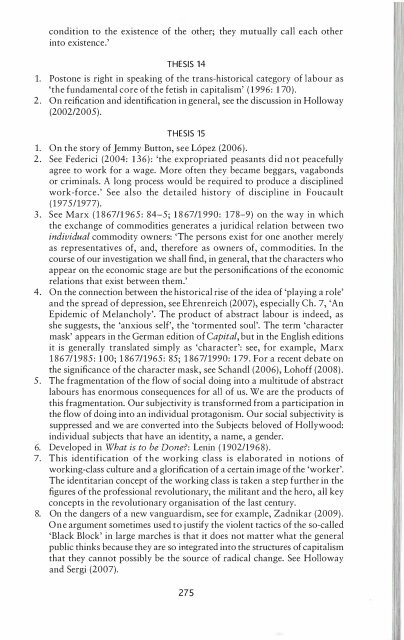Holloway - Crack Capitalism.pdf - Libcom
Holloway - Crack Capitalism.pdf - Libcom
Holloway - Crack Capitalism.pdf - Libcom
Create successful ePaper yourself
Turn your PDF publications into a flip-book with our unique Google optimized e-Paper software.
condition to the existence of the other; they mutually call each other<br />
into existence.'<br />
THESIS 14<br />
1. Postone is right in speaking of the trans-historical category of labour as<br />
'the fundamental core of the fetish in capitalism' (1996: 170).<br />
2. On reification and identification in general, see the discussion in <strong>Holloway</strong><br />
(2002/2005).<br />
THESIS 15<br />
1. On the story of Jemmy Button, see Lopez (2006).<br />
2. See Federici (2004: 136): 'the expropriated peasants did not peacefully<br />
agree to work for a wage. More often they became beggars, vagabonds<br />
or criminals. A long process would be required to produce a disciplined<br />
work-force.' See also the detailed history of discipline in Foucault<br />
(1975/1977).<br />
3. See Marx (186711965: 84-5; 186711990: 178-9) on the way in which<br />
the exchange of commodities generates a juridical relation between two<br />
individual commodity owners: 'The persons exist for one another merely<br />
as representatives of, and, therefore as owners of, commodities. In the<br />
course of our investigation we shall find, in general, that the characters who<br />
appear on the economic stage are but the personifications of the economic<br />
relations that exist between them.'<br />
4. On the connection between the historical rise of the idea of 'playing a role'<br />
and the spread of depression, see Ehrenreich (2007), especially Ch. 7, 'An<br />
Epidemic of Melancholy'. The product of abstract labour is indeed, as<br />
she suggests, the 'anxious self', the 'tormented soul'. The term 'character<br />
mask' appears in the German edition of Capital, but in the English editions<br />
it is generally translated simply as 'character': see, for example, Marx<br />
1867/1985: 100; 186711965: 85; 1867/1990: 179. For a recent debate on<br />
me significance of the character mask, see Schandl (2006), Lohoff (2008).<br />
5. The fragmentation of the flow of social doing into a multitude of abstract<br />
labours has enormous consequences for all of us. We are the products of<br />
this fragmentation. Our subjectivity is transformed from a participation in<br />
the flow of doing into an individual protagon ism. Our social subjectivity is<br />
suppressed and we are converted into the Subjects beloved of Hollywood:<br />
individual subjects that have an identity, a name, a gender.<br />
6. Developed in What is to be Done?: Lenin (1902/1968).<br />
7. This identification of the working class is elaborated in notions of<br />
working-class culture and a glorification of a certain image of the 'worker'.<br />
The identitarian concept of the working class is taken a step further in the<br />
figures of the professional revolutionary, the militant and the hero, all key<br />
concepts in the revolutionary organisation of the last century.<br />
8. On the dangers of a new vanguardism, see for example, Zadnikar (2009).<br />
One argument sometimes used to justify the violent tactics of the so-called<br />
'Black Block' in large marches is that it does not matter what the general<br />
public thinks because they are so integrated into the structures of capitalism<br />
that they cannot possibly be the source of radical change. See <strong>Holloway</strong><br />
and Sergi (2007).<br />
275

















